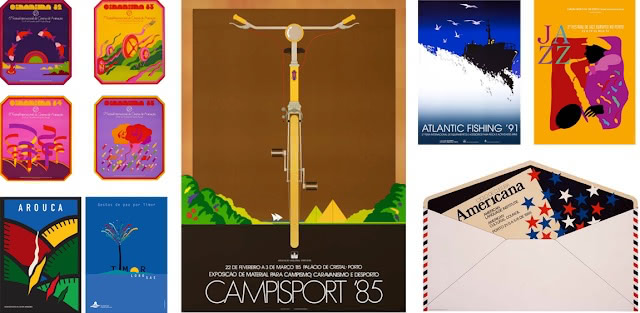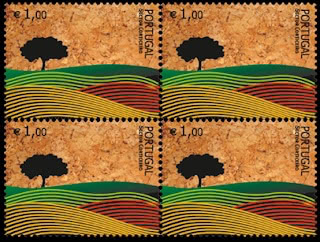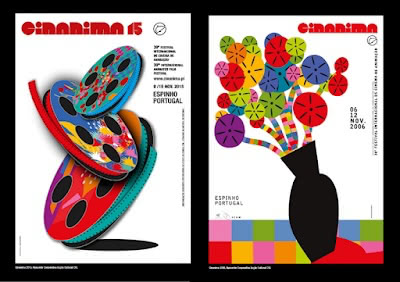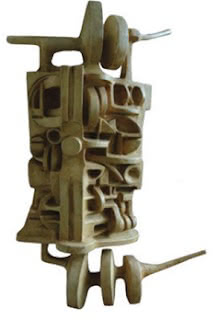João Machado is an internationally known designer based in Portugal. Although his first love is poster design, he began designing stamps for Portugal’s national postal service in the 1980s. Since then, he has designed dozens of stamps celebrating Portugal’s national culture, ecosystems, industries, and aspirations.

Sometime ago, João very generously shared his time and perspectives with Clarisse (aka CStar9) via email and postal mail.

- You are internationally known for your poster designs. How did you begin designing stamps, which are at a very different spatial scale?
-
I started designing stamps in 1987 at the request of CTT – Correios de Portugal (aka, the Portuguese Post).
I made my first stamp for the centenary of the vinyl record. It was a stamp made manually (drawn and colored) without the help of computers.
- What are the primary tools you use in your work?
My first work as a graphic designer was illustrating children’s books. I used pastel and cardboard templates that helped me define the shapes of each drawing. I also drew a lot with India ink.
Later, in the 70s, when posters became my great passion, I drew everything manually, using the airbrush, cutouts, and collages.

A selection of Machado’s early posters In 1987, I bought my first computer, but it was only later, in 1993, that I started using it 100%.
- You’ve even designed a stamp on cork! Can you tell us about that?

I designed this stamp on ‘cork paper’ in 2007, at the request of Corticeira Amorim, a company that leads the world in this sector. This is the first stamp made in this material for Correios de Portugal, and the production was backed by Parliament.
Cork is Portugal’s only world-leading industrial sector, and the cork and cork tree are national symbols. The tree – which may live as many as two hundred years – is mainly concentrated in the centre and the south of Portugal.
- Your vibrant color palette is incredible! Is it inspired by your environment or does it simply exist in your creative imagination?
There are many subjects, places, sounds, images, and even dreams that have obviously had an impact on my color palette and in my way of being an artist. I have always lived in the North of Portugal, next to the river and the sea. The northern region has always been much richer and more prolific in the colors of its crafts. But in a more general way, I am European and this geographic reality strongly influences my personality.
Influences are inevitable when we live in an open society. I’ve traveled a lot and contact with other international designers has been constant. No doubt I was influenced by the impact of Pop Art: I can highlight the influence of Heinz Edelmann, Milton Glaser, and Seymour Chwast. I remember my early works as an illustrator and poster designer were made during the 1960s, listening to the Beatles.

Two of Machado’s posters for the International Animated Film Festival I ended up creating a very unique chromatic code, with vibrant, clean and sharp colors, articulated without any concern for classical correspondence. For example, green does not always mean hope; black does not always mean mourning. The color of the sun or the sea are those that my imagination and intuition decide to choose.
- You’ve said in a previous interview that when you approach a design, you try to land on the bright side of an issue. Can you give us an example?
I am by nature a pessimistic and introspective person, but in my work I am always focused on the positive side of the issue.
In other words, even if it is a delicate and irremediable subject, I always try to approach the content of the message in a positive and hopeful way. Environmental issues are examples of what I have just explained.

Machado stamps with a message - When did you first see yourself as an artist/designer?
-

Machado. Without Title (I), 1967;
plaster; 59×38×15 cmSince I was very little, I had a tendency to draw. When I was 14 years old and went to high school, I remember that my exercise books were filled with varied comic strips, caricatures of the teachers, and other ideas that occurred to me during lessons. I’m sure that at this age I had already decided my future!
When choosing my university career, I chose Fine Arts, which at the time included painting, sculpture, and architecture. I opted for sculpture due to my passion for the three-dimensional and strong drawing components of the course.
Later on in my work as a designer, the impact of sculpture gave me a better understanding of the three-dimensionality and “sensuality” of forms, not just those of the human figure. But the color was missing!
Graphic design gradually appeared on my path. I made the choice to dedicate myself to it, studying, observing, and creating my own language. Now, I was making my own 'watermark’.

More of Machado’s stamps!
You can learn more about João on his website, or through one of the many documentaries and interviews or profiles he’s been featured on throughout the years.
And now, for a very special giveaway! Clarisse is going to send 3 of João Machado’s cork stamps to 3 randomly selected postcrossers. For a chance to win one of these exceptional specimens, let us know which stamp issue(s) from your country you consider to be the most beautiful — maybe one day, we’ll interview that stamp artist too! 😍 This giveaway will close on Saturday, November 1 November 8.
And the winners of this giveaway, as chosen by Paulo’s random number generator are… salcedou, an-foxy and Sudharshan! Congratulations, and thank you all for participating!

































 My first postal commission was Year of the Horse 2014 for Guernsey Post (read more about that philatelic series
My first postal commission was Year of the Horse 2014 for Guernsey Post (read more about that philatelic series 




 I’m proud that I am a good problem solver. I’m good at teaching myself how to do anything I put my mind to.
I’m proud that I am a good problem solver. I’m good at teaching myself how to do anything I put my mind to.






